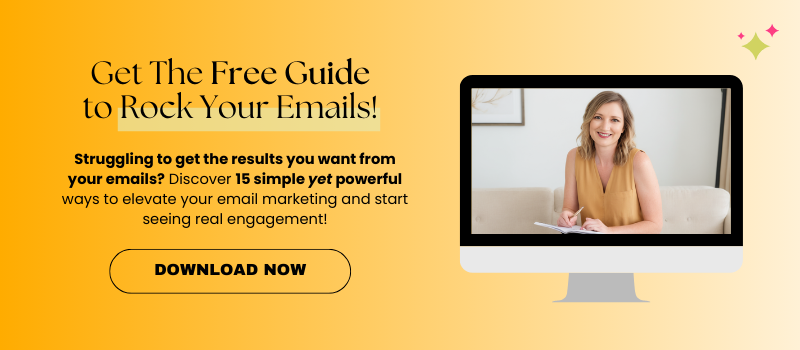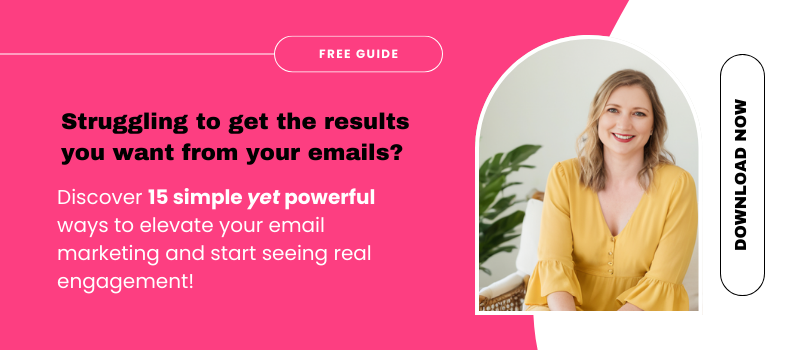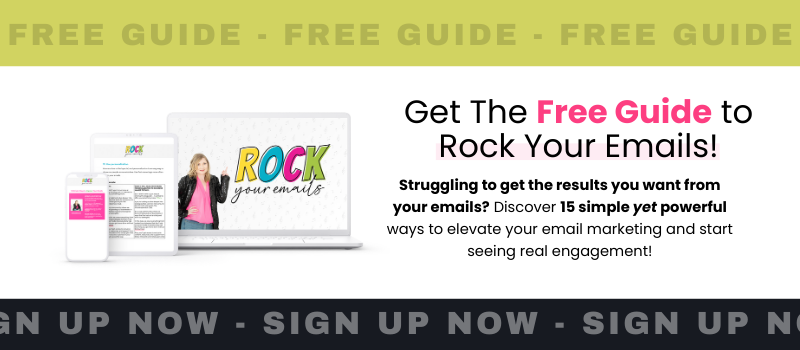Struggling to get the results you want from your emails?
Discover 15 simple yet powerful ways to elevate your email marketing and start seeing real engagement!
Grab your freebie!
Blog Categories
Helping small business owners, virtual assistants, and creative entrepreneurs grow their business.
Hi, I'm Tara! I'm a multi-passionate business and marketing coach.
learn more + get a copy:
Last Updated on October 13, 2025 by Tara Reid
Ever opened an email just because the subject line piqued your curiosity? You’re not alone. Catchy email subject lines aren’t just a headline — it’s the deciding factor for whether your message gets opened or ignored. For entrepreneurs juggling marketing strategies, perfecting this small piece of content can lead to big payoffs in open rates and conversions.
Disclaimer: I earn from qualifying purchases. Some of the links on my website are affiliate links, which means, at no additional cost to you, I will earn a small commission if you click through and make a purchase.
That’s where Open-Worthy: Subject Line Secrets comes in. This resource breaks down 25 proven subject lines that actually work and shows you how to tailor them for your audience. If you’re ready to craft subject lines your email list can’t resist, this is your next step.
And if you’re itching for more ways to level up your email game, don’t miss my tips on improving your email marketing.
- Why Catchy Email Subject Lines Matter
- Key Characteristics of Catchy Email Subject Lines
- Common Mistakes to Avoid in Email Subject Lines
- Top Subject Line Formulas That Work
- Testing and Optimizing Your Email Subject Lines
- Leveraging Catchy Subject Lines Across Different Niches
- Integrating Catchy Email Subject Lines into Your Email Strategy
- Taking Action with “Open-Worthy: Subject Line Secrets”
- Conclusion
Why Catchy Email Subject Lines Matter
Let’s face it — your email’s subject line is like the welcome mat to your house. It’s the very first thing people see. If it’s boring or unclear, your email gets ignored faster than a spam message on a Monday morning.
A catchy email subject line grabs attention, ignites curiosity, and hints at the value inside the email.
But why does this matter so much?
1. First Impressions Are Everything
Subject lines determine whether your email gets opened or passed over. Think about how many emails flood your inbox daily. A subject line that’s clever, clear, or intriguing stands out and can even feel like a personal nudge.
On the other hand, vague or uninspired lines blend into the noise. If you can’t hook them with the first few words, they’re likely scrolling by.
It’s not just my opinion. Studies repeatedly show that subject lines directly increase open rates. According to Campaign Monitor, emails with well-crafted subject lines are significantly more likely to be opened. It’s proof that the effort you put into those simple words can make or break your email’s success.

2. They Tell Readers What to Expect
People are busy — and picky. Your audience doesn’t want to waste time opening an email unless it’s worth their time.
A catchy subject line gives them a preview of the email’s content. It signals whether there’s something valuable inside, whether it’s a solution to a problem, an exciting update, or a juicy freebie.
Think of it as a promise: your subject line sets the tone, and the email body needs to deliver on what you’re promising upfront. Fail to do so, and you’ll erode trust in your emails altogether.
3. Curiosity Sells
Psychology plays a big role here. Catchy subject lines trigger curiosity. They make readers ask questions like, “What do they mean by that?” or “How does this help me?”
It’s the same reason movie trailers work — they tease just enough to make you crave more.
For example, subject lines like “You’re Missing Out on This One Thing” or “The Secret to Doubling Your Sales (It’s Not What You Think)” are hard to ignore because they push you to find the answer.
To refine your skills, check out the Open-Worthy: Subject Line Secrets resource, which offers 25 proven examples you can customize for your own audience. It’s a game-changer for crafting subject lines that spark interest.
4. The Key to Better Conversions
Let’s talk business. Open rates are the first step in the marketing funnel. If nobody opens your email, it doesn’t matter how beautifully designed or convincing your offer is… it’s a dead end.
By nailing down catchy email subject lines, you’re increasing the odds that your message will be read.
According to Chris Fenning, subject lines act as a headline for your entire message. This headline either compels the reader to see what’s inside or turns them away. That’s why this small tweak often leads to big improvements in conversions and sales.
5. They Create a Personal Connection
Subject lines also help you build relationships with your audience. How? By speaking directly to their needs or emotions.
Using personalization — like their name or referencing something timely — makes your emails feel not just catchy but intentional and thoughtful.
For instance, “Sarah, We Picked This Just for You” feels much more engaging than a generic “Our Latest Updates.”
And trust me, people notice. Email marketing is one of the most personal ways to reach your audience. Don’t waste that opportunity by being bland or robotic. If you need tips on sharpening your email marketing approach, check out my insights on improving your email marketing.
The Bottom Line
Think of your subject lines as keys. They unlock the door to your emails, but only if they’re strong enough to turn the lock. Every line you craft is a chance to stand out, stay memorable, and make an impact.
Ready to elevate your email marketing strategy? It all starts with a commitment to making your email subject lines sharper, smarter, and irresistibly clickable.

Key Characteristics of Catchy Email Subject Lines
The subject line is the linchpin of any email campaign. It’s the first thing readers see, and it drives that critical decision to open or not. A strong subject line grabs attention, piques interest, and sets clear expectations.
Let’s break down the essential traits of attention grabbing email subject lines and why they work.
Clarity and Simplicity
In a world overwhelmed by digital noise, clarity is king. Subject lines that are clear and direct outperform vague or wordy ones.
Why? People want to know what they’re getting without unnecessary guesswork. When your subject line mirrors the email’s content, it sets a transparent expectation, reducing the chances of disappointment.
For example, compare these two lines:
- “Important Information!”
- “Action Required: Verify Your Account Details Today”
The latter is not only more specific but also actionable. It conveys exactly what the reader can expect inside the email.
Avoid cramming too many concepts into one sentence. Simplicity doesn’t just enhance readability — it also builds trust. A concise subject line feels confident and reliable, making the recipient more likely to click.
If you want to see other ways to streamline your marketing language, check out insights on how introverts can sell better with clear, simple words.
Creating Curiosity
Ever clicked an email because the subject line planted a question in your mind? That’s the power of curiosity.
Crafting a line that teases just enough information keeps your audience intrigued. Think of it as a movie trailer that reveals just enough to get you hooked.
Examples that spark curiosity:
- “The One Mistake You’re Making in Your Morning Routine”
- “What Happened After We Tried This Viral Trend”
These subject lines create a little mystery. They make the reader wonder, “What is this about?” or “Am I making that mistake?” It’s like leaving the door slightly ajar… you can’t help but peek inside.
However, balance is crucial. Over-promising or being too cryptic can frustrate readers. The goal is to entice, not confuse.
For more examples of how to spark interest in your email campaigns, Mailchimp’s guide on catchy email subject lines is a handy resource.
Relevance and Personalization
Generic subject lines are the fastest way to land in the “ignore” pile. When you tailor your message to the recipient’s interests, preferences, or behavior, it stands out. Emails with personalized subject lines are often seen as more valuable and relevant.
Think about these comparisons:
- Generic: “Our Latest Blog Post”
- Personalized: “Sarah, This Blog Post Was Written for You”
Notice the difference? Including the recipient’s name, referencing a past purchase, or even considering their location makes the email feel like it was crafted just for them.
In fact, personalized emails earn higher open rates because they feel less like spam and more like a conversation.
Using email segmentation tools can help you craft these tailored messages effectively. There’s no one-size-fits-all in email marketing, which is why services like ethical marketing practices, as discussed in my post on increasing conversions through ethical marketing, can fine-tune your strategies.
The Power of Numbers and Lists
When it comes to email subject lines, numbers are your secret weapon. Why? They add structure and a clear takeaway for the audience.
For instance, a line like “6 Tips to Save Time While Working from Home” stands out more than “How to Be More Productive.” Numbers prep the reader by setting a clear expectation.
A few examples where numbers work wonders:
- “5 Hacks for Perfectly Organized Projects”
- “Win Big: 3 Surprising Lessons from Top Entrepreneurs”
- “Top 10 Skincare Secrets That Actually Work”
These subject lines work because they promise value in a quick, digestible format. People don’t have time to guess or decode — they want clear, actionable content. Even if your audience is hesitant to click, the specificity of numbered subject lines can sway them.
Data also supports this approach. According to Mailmunch, emails incorporating numbers have consistently higher open rates because they speak directly to busy readers looking for fast solutions.
By sticking to these key principles — clarity, curiosity, relevance, and numbers — you’re setting your email campaigns up for success.
The subject line isn’t just text; it’s your hook, your promise, and, sometimes, your only chance to engage.

Common Mistakes to Avoid in Email Subject Lines
Crafting email subject lines is less about flair and more about strategy. Even the most captivating content won’t matter if your subject line fails to get people to open the email.
Here’s where most marketers stumble… and how to avoid these pitfalls.
Mistake #1: Being Too Generic or Unclear
If your subject line could apply to any email in any industry, it’s too generic.
Think about it… would you open an email titled “Updates from Us”? Probably not.
Readers crave specificity and relevance. A generic subject line lacks both and winds up being an easy target for the “delete” key.
Instead, focus on tailoring your lines to your audience. Speak their language or reference something specific about their interests or behaviors.
If you’re looking to refine your email strategies further, take a look at how to simplify your email marketing.
Mistake #2: Using ALL CAPS or Over-the-Top Punctuation
Emails screaming “READ THIS NOW!!!” with excessive caps or exclamation points scream desperation. Your audience doesn’t want to feel yelled at – they want to feel understood. Overusing punctuation also makes your message look spammy, which can trigger spam filters before users even see your email.
A simple, polished tone always wins out. Whether you’re sharing new deals, resources, or updates, the subject line should feel professional and exciting, not forced.
Mistake #3: Ignoring Mobile Optimization
Ever opened an email on your phone and been greeted by a subject line that trails off awkwardly? Mobile users make up a large portion of your audience, and overly long subject lines get cut off.
Aim for subject lines under 40 characters to ensure the most important part of your message comes through.
Mobile optimization isn’t just good design, it’s essential for keeping up with your audience where they are. Studies show emails that are optimized for mobile perform better across the board. AWeber’s guide dives deeper into this and other email subject lines best practices.
Mistake #4: Overloading with Emojis or Spam Words
Emojis can be a powerful tool to convey emotion or context, but overuse can backfire. 🔥🔥🔥 might catch the eye momentarily, but it can come across as gimmicky or cluttered if not aligned with your audience.
Worse, spammy words like “free,” “limited-time offer,” or “win big” often land emails in the junk folder.
Instead, reserve emojis for occasions when they truly enhance the message and pair them with clear, benefit-driven language.
Mistake #5: Relying on Clickbait Tricks
Subject lines like “This Will Change Your Life Forever” often feel detached from the actual content of the email. If recipients feel duped after opening your message, they’re less likely to trust your future emails.
Clickbait may work for one email, but it’s detrimental to long-term engagement.
A better approach is enticing curiosity while delivering on the promise. Subject lines should act like a handshake… not a bait-and-switch tactic. You’ll gain credibility and build reader trust.
Mistake #6: Forgetting Personalization
Failing to personalize subject lines feels like ignoring the person on the other side of the screen. With tools that allow for segmentation and personalization, there’s no excuse for emails that feel one-size-fits-all. Consider this comparison:
- Bland: “Latest Updates from [Company Name]”
- Engaging: “Madison, Here’s What You Missed This Week”
Adding a recipient’s name or referencing their recent activity makes the email feel instantly more relevant. Tools like those featured in ethical marketing strategies can help you segment your audience effectively.
Avoiding these common mistakes ensures your emails not only get opened but also leave a lasting impression. With strong, strategic subject lines, you’ll position your content for maximum success.

Top Subject Line Formulas That Work
Your subject line is your first impression, your opening statement, and sometimes your only chance to grab attention. It needs to be precise, compelling, and irresistible. Not only does it set the tone, but it also makes or breaks your open rates.
Let’s dive into proven formulas that consistently perform.
1. Question-Based Subject Lines
Questions provoke curiosity. They pull readers in by promising answers to a problem or something they’re eager to solve. A well-placed question subject line can feel like it’s speaking to the reader directly, sparking intrigue.
Why do they work so well? People naturally feel compelled to resolve open-ended situations. It’s like stopping mid-story… you just have to know the ending.
For example:
- “Are You Making This Common Marketing Mistake?”
- “What’s the Secret to Doubling Profits in 30 Days?”
These lines don’t just ask — they engage and invite the reader to ponder. But a warning: don’t use vague or overly generic questions like “What’s Next?”
If you need inspiration, check out my guide on improving your email marketing.
2. How-To Subject Lines
“How-to” subject lines are classics for a reason. They promise instant value and establish you as a guide. Imagine your reader is standing at the edge of a problem — they want solutions, and your subject line is the hand that pulls them across.
Examples include:
- “How to Write Emails That Boost Sales by 40%”
- “How to Save 10 Hours a Week with This Simple System”
These formulas work particularly well with actionable tips or tutorials. The key is to focus on benefits. You’re not just describing a method, you’re selling a transformation.
For more examples on what works, Mailchimp’s email subject lines best practices guide is worth exploring.
3. Urgency and FOMO
Creating a sense of urgency or playing into the fear of missing out (FOMO) is one of the fastest ways to trigger action. Subject lines that include time-sensitive language ignite a sense of “act now or regret later.”
Some examples to consider:
- “Last Chance! Sale Ends Tonight”
- “Only 3 Spots Left—Reserve Yours Now”
Use this formula sparingly. Overusing urgency can erode trust, making your emails less impactful over time.
If you want more advice on ethical marketing and how to keep trust intact, explore my piece on increasing conversions through ethical marketing.
4. Story-Based Subject Lines
Humans are wired to respond to stories. Starting your emails with a narrative or an intriguing scenario creates instant engagement. You’re not just asking your reader to open your email — you’re inviting them into a story.
For example:
- “I Tried This Wild Idea — And It Worked”
- “She Made One Change and Increased Revenue by 50%”
These subject lines don’t just catch the eye. They make readers feel like they’re missing out on an incredible tale.
Curiosity drives clicks. Just make sure the email delivers on the story teased in the subject.
Need more help with creative storytelling? Check out this podcast episode.
In each case, these formulas do one thing brilliantly: they connect with your reader’s emotions or curiosity. Combine these strategies with a little personalization, and you’ll see open rates rise in no time.
Testing and Optimizing Your Email Subject Lines
Writing a catchy email subject line is only half the battle. Testing and optimizing those lines are the steps that ensure your hard work actually pays off. Think of it like tweaking a recipe; you want to keep experimenting until it’s just right.
Fortunately, several tools and strategies exist to help you find the subject lines that will resonate most with your audience.
Using Subject Line Tools
Sometimes, figuring out the effectiveness of your email subject lines feels like throwing darts in the dark. That’s where subject line testing tools come in. They provide clarity, scoring your subject lines and offering feedback to guide improvements.
One tool I’ve found helpful is the CoSchedule Headline Analyzer, which evaluates emotional appeal, readability, and word balance in your subject lines. It gives you a score and real-time suggestions, making it easier to spot what works and what needs tweaking.
Other tools, like Omnisend’s Subject Line Tester, can also be a game-changer, giving you actionable insights on open rate predictions, spam triggers, and keyword optimization.
Tools like this serve as a second pair of eyes for your emails — they pick up nuances you might have missed.
Additionally, you could try the Mailmeteor Subject Line Tester, which uses AI to help identify alternative phrasings and pinpoint weak spots in your subject line strategy.
By consistently running your subject lines through these tools, you’re ensuring every email has its best chance of standing out in a crowded inbox.
Interpreting Open Rate Metrics
Testing tools give you insights upfront, but the real proof is in how your audience responds. Open rate metrics are like the applause at the end of a performance — they tell you if people are engaging with what you’ve created.
But how do you analyze this data effectively?
Start by examining your open rates over a specific time frame. Pay attention to which subject lines scored the highest and look for patterns.
Did a particular tone, like curiosity-driven phrases or urgency, yield better results? Are personalized subject lines (e.g., ones with a recipient’s name) driving more opens?
Tools like those highlighted in Segmentify’s A/B testing guide can further refine your understanding by enabling split tests and delivering precise metrics on performance.
Segmenting your audience and testing variations of the same email can also provide critical insights.
For instance, you might test “A Free Checklist for You, Sarah” against “Don’t Miss This Useful Checklist.” Measure their open rates and let the data guide your future directions.
By consistently iterating based on your results, you’re not just relying on chance — you’re building a strategy grounded in data-driven decisions.
Finally, remember that even smaller tweaks can yield significant results.
For example, studies have shown that shorter subject lines often perform better on mobile, where space is limited. Adjusting based on device usage metrics can help you capture clicks from an on-the-go audience.
Testing and interpreting these metrics isn’t just about getting higher numbers; it’s about understanding your audience and speaking their language.
If you’re looking for more strategies, my post on simple ways to improve your email marketing offers additional tips you can weave into your campaigns.

Leveraging Catchy Subject Lines Across Different Niches
A great subject line can be a marketer’s secret weapon. It’s not just about grabbing someone’s attention — it’s about ensuring your email aligns with what your audience values.
Crafting subject lines that resonate across various niches requires understanding each segment’s unique needs and framing your message accordingly.
Let’s break it down further by exploring how to approach different industries.
Service Providers: Building Curiosity and Trust
Service providers thrive on relationships. Whether you’re a coach, consultant, or freelancer, you need subject lines that connect emotionally and establish trust.
Think about what keeps your audience up at night: is it finding more clients, streamlining processes, or reaching their life goals?
Here are examples that work well for service providers:
- “Overwhelmed? Try This 10-Minute Productivity Hack”
- “The Secret to Getting More Clients Without Burnout”
These lines immediately signal value and offer tangible solutions. They grab attention and promise answers to real challenges. When paired with personalized touches, like a recipient’s name, these subject lines become even more powerful.
For additional inspiration, consider exploring resources like 101 Email Subject Lines That Subscribers Can’t Resist. This compilation offers insights into what consistently works across different contexts.
Course Creators: Highlighting Exclusivity and Benefits
If you’re a course creator, your audience is hungry for knowledge. They’re seeking solutions to specific problems or support to achieve their goals. Subject lines that emphasize exclusivity while spotlighting clear benefits tend to resonate.
Here are examples that could work:
- “Only 5 Spots Left: Enroll in ‘Master Your Marketing’ Today”
- “New Lesson Alert: Increase Your Sales in 3 Steps”
These phrases create urgency while delivering value upfront. By making your offerings feel timely and indispensable, you’re creating the kind of FOMO (fear of missing out) that boosts clicks… and conversions.
Insight-driven tools like the Open-Worthy: Subject Line Secrets, which I designed specifically for niches like this, can take these ideas further. With templates tailored for course creators, you’ll always have a supply of fresh concepts.
Coaches: Speaking to Transformational Results
Coaching is all about transformation. When crafting subject lines, focus on the outcomes you help people achieve. What’s at stake, and how can you make their desired future feel within reach?
Here’s how you can do it:
- “Transform Your Morning Routine in One Week”
- “From Stuck to Thriving: See What’s Possible With Coaching”
These subject lines present a vision of success and invite readers to take a step toward it. They work because they don’t just sell coaching — they make the reader picture their life with those changes.
You can find additional frameworks for subject lines designed to drive results in resources like Catchy Subject Line Library.
Ecommerce Brands: Promoting Deals Without Sounding Spammy
For ecommerce, your emails are often about driving sales — but that shouldn’t come at the cost of creativity or authenticity. While discounts and deals are important, subject lines can still be engaging and relationship-focused.
Examples include:
- “You Won’t Believe This Deal (48 Hours Only!)”
- “Our Bestselling Skincare Is Back in Stock!”
Both examples use action-oriented words that encourage urgency but avoid sounding robotic or spammy. The key is to balance promotional language with warmth and excitement.
Dive deeper into strategies unique to ecommerce in the guide Eye-Catching Email Subject Lines.
By understanding the nuances of each niche and creating targeted subject lines, you can ensure your emails not only get opened but leave a lasting impression. Tailoring your message is the universal secret for email marketing success!
Integrating Catchy Email Subject Lines into Your Email Strategy
A great subject line isn’t just an attention-grabber; it’s the ticket to higher open rates and deeper connections with your audience. But subject lines don’t operate in a vacuum — they’re part of a bigger picture.
When integrated strategically into your email plan, they set the stage for success, building trust and driving engagement.
Creating Segmented Lists
Segmenting your audience is like putting together a playlist — each group gets content that matches their specific interests.
Why does this matter for subject lines? Because relevance is everything. If your emails are tailored to what recipients care about, your subject lines will feel more personal — and irresistible.
Here’s how segmented lists can work wonders:
- Higher relevance: Send specific messages to groups like new subscribers, loyal customers, or freebie downloaders. For instance, a subscriber who always clicks on your “how-to” blog posts would likely respond to a subject line like, “How to Level Up Your Skills in 3 Easy Steps.”
- Better testing: When you test subject lines on smaller, segmented groups, you can refine what works before rolling it out to your whole audience.
Not sure where to start with segmentation? Check out how you can implement these strategies step-by-step in my guide to growing your email list effectively.

Crafting Emails That Complement Your Subject Lines
Imagine inviting someone to a thrilling movie premiere only for them to walk into a blank screen. That’s what it feels like when your email doesn’t deliver on the excitement promised in your subject line.
Consistency between the subject line and email body is a trust-builder in email marketing.
Here’s how to keep your promise:
- Match the tone: If your subject line is light and fun, like “Ready for a Surprise That’ll Make Your Week?”, make sure the email maintains that tone throughout.
- Provide value right away: If you’re teasing “The Cheat Sheet You’ll Want to Bookmark,” ensure the email immediately delivers on that promise.
- Keep it aligned: The subject line and email content should flow naturally. The goal? Make clicking through feel like pressing “play” on a satisfying story.
If you’re looking for tips on how to align your emails with audience expectations, check out my post on writing impactful emails.
Creating an Enticing Welcome Email Sequence
The welcome sequence is your first impression — your chance to leave a mark and set reader expectations. This is the perfect opportunity to flex your creativity with catchy subject lines.
Here’s how to make your welcome emails shine:
- Start strong: Open with curiosity-packed subject lines like, “Let’s Get Started: Here’s Your Free Toolkit!” or “Welcome to Our World — Here’s What’s Next.”
- Build anticipation: Use sequence-based lines like “Day 2: Your Next Exclusive Tip Awaits.”
- Test and adapt: Experiment with different tones or approaches to see what clicks with your audience. This is your chance to refine your style while they’re paying close attention.
To create a seamless and engaging welcome email sequence for your new subscribers, don’t miss out on my step-by-step insights in this guide. It’s all about starting on the right foot with emails your audience will love.
Taking Action with “Open-Worthy: Subject Line Secrets”
If you’re serious about boosting your email open rates, this is the moment to take action. The way you approach subject lines can turn casual readers into loyal subscribers or eager buyers.
With the Open-Worthy: Subject Line Secrets guide, you’ve got everything you need to unlock that potential.
This resource isn’t just a list of ideas — it’s your toolbox to create subject lines that deliver results, offering 25 proven templates, customizable email outlines, and examples tailored to different niches.
Shifting from Guesswork to Strategy
Let me ask you — how much time do you spend brainstorming email subject lines? If you’re like most entrepreneurs, it’s either way too little or way too much without feeling confident about the results.
Here’s the truth: crafting “open-worthy” subject lines isn’t a guessing game. It’s a strategy that blends psychology, precision, and proven formulas.
The guide takes the guesswork out of the equation by providing the exact subject lines that drive clicks. It’s not about reinventing the wheel; it’s about taking what works and making it work for you.
For tips on personalization that align closely with this strategy, check out why introverts can sell better with adapted techniques.
The “Open-Worthy” Framework at a Glance
What makes the subject lines in this guide so effective? They follow a framework that taps into tested formulas like:
- Curiosity triggers: These subject lines spark immediate interest and make people think, “I need to see this.” Example: “This One Small Change Could Revolutionize Your Workflow.”
- Numbers and lists: People love digestible, specific results. Example: “5 Quick Wins to Boost Your Open Rates Today.”
- Personalization: Name references, location-based phrases, or notes about behavior. Example: “Alex, Stop Doing This to Your Marketing Emails.”
You’ll also learn how to adapt these frameworks for your audience. Whether you’re an ecommerce brand or a coach, the Open-Worthy approach fits seamlessly into your campaigns.
Why Customization Matters
Everyone’s audience is different. What excites one group might bore another, which is why customization is key.
With templates and ideas for niches like service providers, coaches, and course creators, this guide ensures you’re not just grabbing attention but keeping it focused on what your audience cares about.
With Open-Worthy: Subject Line Secrets, you don’t just learn why subject lines work; you learn how to tweak them perfectly for your audience.
Are you ready to take your email strategy from decent to unstoppable? Then it’s time to put Open-Worthy into play and watch those open rates soar.
Conclusion
Catchy email subject lines aren’t just an accessory to your email marketing strategy — they’re the cornerstone of your email marketing success. They drive opens, boost engagement, and lay the groundwork for meaningful connections with your audience.
If you’re ready to sharpen your email skills and see real results, Open-Worthy: Subject Line Secrets is your go-to resource. With 25 proven subject lines, customizable examples, and tailored email outlines, it’s built to make your content irresistible. Take the guesswork out of your campaigns and start creating emails your audience can’t wait to open.
Don’t settle for decent when you can deliver exceptional. Test, tweak, and watch those open rates climb — your next subject line could be the one that changes everything.
Tara Reid is a multi-passionate business and marketing strategist for introverted entrepreneurs who want to grow without relying on hustle culture or social media. With 18+ years of online business experience, she helps course creators, service providers, and digital product sellers build sustainable businesses through evergreen marketing, blogging, SEO, Pinterest, and email.
As the founder of the Introvertpreneur Club, Tara’s mission is to show heart-centered entrepreneurs that you don’t have to be loud to be successful. You just need the right strategies that fit your personality.
When she’s not supporting clients or creating new resources, you can find her at home in Canada with her three rescue dogs, a cup of coffee in hand, dreaming up her next project.
The Introvertpreneur Podcast
listen in to the top rated business podcast that is designed for introverted entrepreneurs who want to grow + scale in a more sustainable and fun way!
Top rated podcast
This one's on me. Complimentary free stuff coming right up.
leaving so soon?
Look behind the curtain and see exactly what I do every week, month, and quarter, to market my business without social media (in under 5 hours per week)!
The Quiet Marketing Playbook
Take this free quiz and learn what your superpower is as an entrepreneur. You'll also get a curated list of my best resources and tips for using your superpower to your advantage!
What's your Introverted Superpower?
Best Free Resources:
dig into 'em now!
A business strategist and marketing coach who focuses on helping course creators, coaches, and service providers, build sustainable businesses without social media.
